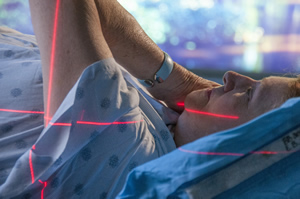Image-Guided Radiation Therapy
 Physicians and patients who are unaware of the applications and benefits of Image-Guided Radiation Therapy (IGRT) may ask what it means for them and their patients. IGRT provides the confidence that patients' treatment fields can be set up daily to within 1-2 mm of accuracy of the original treatment plan. This level of accuracy can only be obtained with new equipment that offers imaging processes that occur in real time. Some of this exciting new technology was first implemented in the region by the Radiation Oncology Department at the Edwards Comprehensive Cancer Center (ECCC) at Cabell Huntington Hospital.
Physicians and patients who are unaware of the applications and benefits of Image-Guided Radiation Therapy (IGRT) may ask what it means for them and their patients. IGRT provides the confidence that patients' treatment fields can be set up daily to within 1-2 mm of accuracy of the original treatment plan. This level of accuracy can only be obtained with new equipment that offers imaging processes that occur in real time. Some of this exciting new technology was first implemented in the region by the Radiation Oncology Department at the Edwards Comprehensive Cancer Center (ECCC) at Cabell Huntington Hospital.
Image-guided radiation therapy is accomplished in several different ways. First, we can acquire higher quality images with a kV X-ray tube attached to the linear accelerator. This innovative technology gives the radiation oncologist the best visual view of the treatment area daily and the ability to make necessary adjustments to either the fields or patient position prior to treatment. You may hear this referred to as OBI or On-Board Imaging.
Secondly, Cone Beam CT (CBCT) is a 3-D imaging technique that increases the precision of setting up treatment fields, including fields used in intensity modulated radiation therapy (IMRT). It allows the therapist to eliminate some variations that can occur from day to day set-ups (e.g., rectum and bladder filled differently each day, patient distended from hydration, patient just doesn't lie in quite the same position daily). After the patients are set up for their treatment, but before the beam is turned on, a CT data set is acquired and is then compared with the patient's original CT that was used for planning. This is done by "matching" either bone or preferably soft tissue from one CT to the other. Once the match is satisfactory, the treatment table is repositioned as needed so that the beam is centered precisely on the area to be treated. In some cases, this type of imaging may also allow the physician to monitor tumor response.
Lastly, respiratory gating or Real-Time Position Management (RPM) may benefit patients that require treatment for lung cancer, but are hesitant to proceed with radiation due to poor pulmonary function. Gating capabilities allow the machine to only treat when the tumor is in the center of the field. This is accomplished by monitoring the patient's respirations. This allows us to spare more normal lung tissue, as opposed to traditional fields that would have to be larger due to inspiration and expiration. Gating can also be utilized for left-sided breast treatments so that we can further limit dose to the heart.
The staff at the ECCC has many years of experience in radiation therapy, and we take pride in providing your patients with the best care and the newest technologies available. Our physicians, physicists and therapists are all board-certified in radiation therapy. The experience, knowledge and additional training for this technology provide you the confidence you deserve when referring your patients to the ECCC for radiation therapy.
If you have questions about radiation therapy at the ECCC, please call 304.399.6518.
